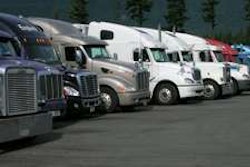While the economic recovery is slowing down, the trucking industry likely won’t feel the effects as much since transportation-dependent manufacturing growth is leading the recovery. That was a conclusion offered July 23 in a freight outlook online seminar presented by FTR Associates, an economics research firm.
“Freight is growing faster than GDP (Gross Domestic Product) because of manufacturing,” said Noel Perry, managing director and senior consultant at FTR Associates.
Perry estimated weaker GDP growth of 3-3.5 percent over the next two years.
This economic recovery is slower compared with past recessions when recoveries were stronger and faster, Perry said. Causes include a weak housing market with a large inventory of unsold used housing and high unemployment.
Truckload growth is slowing as 2009’s manufacturing surge has started slowing, Perry said. Despite that, truckload freight growth exceeds the growth in the nation’s gross domestic product figure. “If manufacturing were to slow down, there would be a disproportionate effect on truck freight,” he said.
Perry estimated 200,000 trucks remain unused on the sidelines. As economic growth slows down, that number will stay high, he predicted.
Despite that, the industry is facing a shortage of trucks as carriers are still recovering from the severe recession, Perry said. As demand for drivers fell the past two years, companies laid off many recruiters and human resources people. Perry said the industry is now capable of hiring 100,000 drivers per quarter, far short of the 150,000 drivers needed by the industry. “We expect it will take them several years to build up the capacity to hire drivers again,” he said.
Perry also pointed to regulatory factors such as the pending revision of the hours of service rule and the approach of Comprehensive Safety Analysis 2010 as further restricting driver availability. He estimated hours changes could reduce driver supply by 2 percent. He said CSA 2010 could reveal about 10 percent of existing drivers are safety risks. “You wonder how many of those people are going to survive [as drivers].”
Perry also mentioned a Department of Homeland Security requirement of states to demand proof of citizenship to obtain driver’s licenses. He said estimates put the number of illegal aliens driving trucks at about 5 percent of the total.
“In 2011 and 2012, the years of capacity shortage, somewhere between 150,000 and 200,000 drivers will be taken out of the market,” Perry said.
Another factor that could limit owner-operator totals is higher interest rates for truck buyers with poor or marginal credit. Earlier in this decade, those drivers paid slightly higher rates than good-credit drivers. Now, rates have fallen for conventional borrowers, but rates have risen sharply for those with poor credit, Perry said.
On fuel, Perry said the industry faces probably a year or two of relatively low prices before higher, volatile prices return to the market.









